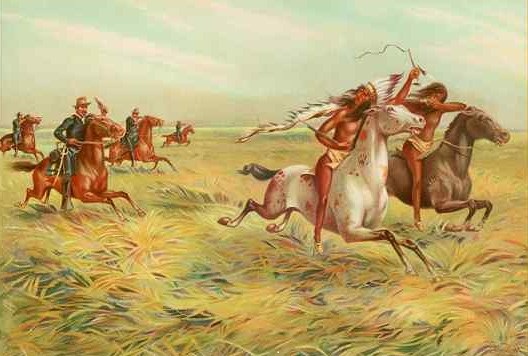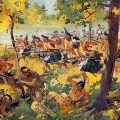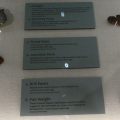
( – promoted by navajo)
By the end of the nineteenth century, it was commonly believed by scholars, politicians, and the general public that Indians were destined to disappear. In the twentieth century, many scholars continue to write as those Indians did, in fact, disappear by the twentieth century. Since there weren’t supposed to be any Indians in the twentieth century, there weren’t supposed to be any Indian wars in the twentieth century. Yet there are many incidents involving military action against Indians as well as the actions of volunteer groups and law enforcement agencies against Indians that can be considered to be Indian “war” similar to those of the nineteenth century.
In 1905, army troops were sent in to quell a disturbance among the Navajo. To show that resistance to the “big stick” policies of the Indian Office (later called the Bureau of Indian Affairs) were futile, seven of the Navajo men were sent to Alcatraz prison. There was no trial.
In 1906, there was a dispute among the Hopi over sending children to boarding schools. In one of the Hopi villages, people labeled as “hostiles” by the government refused to send their children to school. The government sent in police to arrest the leaders. The so-called hostiles then moved from Shongopavi and established a new village at Hotevilla. The government then sent in troops to round up all of the Hopi at Hotevilla and marched them to a temporary camp some six miles away. The men were then marched another 40 miles to Keams Canyon where they were chained together and forced to work on a chain gang for the next 18 months. Two of the main leaders of the “hostiles” were permanently banished from the reservation and 17 other leaders were imprisoned at hard labor at Fort Hauchuca, Arizona. According to Indian Commissioner Francis Leupp: the Hopis must learn “that hereafter they will conduct themselves reasonably like white men or be treated as white people treat those of their own number who are forever quarreling and fighting among themselves.”
In 1911, army troops were called in once again to invade the Hopi reservation. The troops were used to force the children of the village of Hotevilla to attend school. Sixty-nine children were placed under military guard and taken to the boarding school at Keams Canyon. The troops then invaded the village of Shongopovi where they captured three more children for the boarding school.
In 1906, 300 Ute under the leadership of Red Cap left the White River Reservation in Colorado headed for South Dakota. The Ute were upset about the allotment of their reservation and increase of non-Indian settlers. In South Dakota, they hoped to form an alliance with the Lakota and with the Crow to stop the allotment program. The army stopped the group and detained them as prisoners of war at Fort Meade, South Dakota. The army was unconcerned that courts had ruled that Indians could not be detained or imprisoned without a trial. Nor was the army concerned that no actual state of war existed at the time. The army viewed the Ute as potential enemy combatants and felt that it had the right to hold them in prison indefinitely.
While the army often ignored due process of law when dealing with Indians, there are cases in which the army did attempt to see due process carried out. In 1915, a Mexican sheepherder was murdered in Colorado and popular opinion assumed that he had been killed by an Indian. The court of public opinion blamed Tsenegar, a Ute Indian, for the death. Subsequently a posse of 26 cowboys crossed into Utah and surrounded the Ute camp of Old Polk. Their supposed goal was to capture Tsenegar who was rumored to be in Old Polk’s group. The cowboys, who were drunk at the time, began firing into the camp with no warning. The Indians had no idea who these men were nor why they were shooting at them. The Indian response was to fire back to distract the cowboys and then to slip away. When the smoked cleared, there were dead on both sides and the Ute had vanished.
In response to this incident, non-Indians began to raise a cry about an “Indian uprising” and to ask for military help. In the meantime, the marshal sent out word that all Indians in the area were to come into Blanding, Utah and surrender. One group of Ute teenagers who had nothing to do with the shootout at Old Polk’s camp walked into Blanding and gave themselves up. Even though they were innocent of any crime except for being Indian, they were handcuffed and imprisoned under armed guard at the Zion Co-op Store.
Because of the anti-Indian sentiment at this time, the military forcibly removed 160 Ute from their Utah homelands and resettled them on the Ute Mountain Ute Reservation in Colorado.
To capture Tsenegar and Old Polk, the military recruited Bi-joshii, a Navajo medicineman. Bi-joshii made contact with Old Polk and Tsenegar. Through the efforts of trader John Wetherhill and his Navajo wife Slim Woman, the Ute “outlaws” peacefully surrendered to General Hugh Scott. According to General Scott:
“My problem was to prevent those four Indians from being legally murdered. White men had been killed and the trial would be in the hands of white men, possibly prejudiced against the Indian, whose land incidentally was wanted.”
General Scott later wrote:
“I believed that the white man had been the aggressor, but this could be proved only by Indian witnesses whose word would not be taken against that of a white man.”
Tsenegar was tried for murder in Denver, Colorado. Concerned about preserving the image of fairness in this case, the judge appointed leading members of the bar to present Tsenegar’s defense. In court Tsenegar dressed in a gray flannel suit with a red necktie and a red flower in his buttonhole. He wore moccasins and a white felt cowboy hat. One breast was covered with dime store medals and on the other he wore a miniature United States flag.
The first witness for the government was John Miller, a Ute. As the witness began to be sworn, the defense attorney objected, claiming that the oath was not binding on a non-Christian. The judge overruled the objection. After seven hours of deliberation the jury found Tsenegar not guilty.
In 1913 there was a rebellion among the Navajo which came to be known as the Beautiful Mountain Uprising. The uprising started when the Indian agent learned that Hatot’cli-yazzie, the son of Ba-Joshii, had three wives in spite of the agent’s edict against plural marriages. Fed by information from the Indian agent, local newspapers painted a picture of the entire Navajo nation in revolt with a horrible massacre impending. To avert this massacre and save the non-Indians, according to the newspaper accounts, military action was needed. In response, the army sent in the cavalry with 261 men and officers to put down the Navajo “hostiles” who were under the leadership of Ba-Joshii. The Navajo force numbered only twelve men.
There are a number of accounts of actions against Indians by militia groups and volunteers (sometimes in the guise of posses). One of these was the Smoked Meat Rebellion of 1909. This incident started when non-Indians complained about the theft of ham from their smokehouses. Assuming that Indians were guilty, authorities from the state of Oklahoma invaded the traditional Creek encampment at Hickory Ground. While the sheriff and his posse take possession of the campgrounds, there is an exchange of gunfire in which several Creek Freedmen (former slaves) were killed.
The sheriff then secured an arrest warrant for Chitto Harjo on the charge of conspiracy. In the raid on Harjo’s house, gunfire broke out, two deputies were killed, and Harjo escaped. The state of Oklahoma raised a militia of more than 1,000 to put down the Smoked Meat Rebellion. The militia attacked the camp at Hickory Ground, killing many Creek Freedmen, but the traditional Creeks had already broken camp and dispersed.
The Smoked Meat Rebellion was not the first time military action had been used against Chitto Harjo’s traditional Creek. In 1901, the army had been called in to put down the Snake Uprising against the allotment act. The cavalry invaded Hickory Ground and arrested Chitto Harjo and about 100 traditional Creek. After several weeks in jail, they were given long prison sentences which were suspended if they promised to be good. In this instance, the cavalry was not called by the Indian agent, but by Creek chief Pleasant Porter.
Another incident at the same time in California was the hunt for Willie Boy which inspired a number of novels and a major movie. It began when Willie Boy, a Chemehuevi, killed William Mike, another Chemehuevi. Willie Boy then “kidnapped” Mike’s daughter Carlotta. Willie Boy and Carlotta then set off across the desert near Banning on foot.
A posse was then organized to track down the couple. Assisting the posse were two Indian trackers: John Hyde (Yaqui) and Segundo Chino (Chemehuevi). Both of the trackers were friends of the Mike family. The Chemehuevi had a special cult of the runners which had stemmed from the need for chiefs to send messages to others quickly. These runners could cross the desert quickly with little or no water. In the pursuit of Willie Boy the trackers noted that his stride covered 5 to 7 feet. It would appear that Willie Boy was a runner in the old Chemehuevi tradition.
According to the official story, Willie Boy killed Carlotta because she was slowing him down and later killed himself because the posse had worn him down and he was out of ammunition. There was some doubt as to how Carlotta really died-in retrospect the evidence seems to suggest that she was killed by gunfire from the posse. The posse burned Willie Boy’s body rather than bringing it back with them. There are some who feel that Willie Boy did not kill himself because the posse wore him out, but rather he killed himself because he wanted to rejoin Carlotta.
Willie Boy and Carlotta had run off together before and Willie Boy had asked William Mike for permission to marry Carlotta. Permission had been denied because Willie Boy and Carlotta were cousins and this would be incest according to Chemehuevi tradition. In addition, William Mike, a well-known medicine man, disliked Willie Boy.
The press seized upon the story and sensationalized it. The newspaper accounts identified Willie Boy as Paiute. According to the popular newspaper accounts of the incident Willie Boy was drunk and this was the cause of the killing. Willie Boy, however, followed the teachings of the Paiute prophet Wovoka which prohibited the use of alcohol. Willie Boy had a reputation on the reservation for not drinking. The idea of “finding courage in a bottle” makes sense to non-Indians, but does not reflect the cultural reality of the Paiute and Chemehuevi followers of Wovoka.
Not all of the military actions against Indians during the twentieth century took place in the early part of the century. In 1973 there was a standoff between Indians and the military at Wounded Knee, the site of a massacre 82 years earlier. The American Indian Movement (AIM) led a group of traditionals and urban national¬ists in an occupation of the Wounded Knee community. AIM took this action at the request of the Oglala Sioux Civil Rights Organization (OSCRO) led by Pedro Bissonette.
Under the code name Garden Plot, the military played a central role in determining the government strategy in response to the takeover. Military personnel were required to wear civilian clothes and the government vehemently denied the military presence. It was difficult to explain, however, the presence of military tanks, armored personnel carriers, and fighter jets.
While the military publicly denied any role in the siege of Wounded Knee, Army Vice Chief of Staff Alexander Haig ordered two colonels, who are to dress as civilians, to oversee operations there. Army trucks filled with materiel were driven to points near Wounded Knee where the materiel was then transferred to civilian trucks that were then driven to the area by soldiers in civilian dress. The army provided armored personnel carriers, ammunition, rifles, and grenade launchers. The army also sent in a chemical warfare team to train the U.S. Marshals and the FBI. The Air Force provided a jet and three helicopters.
For 71 days Wounded Knee was surrounded by a force of 200 law enforcement (FBI and federal marshals) and military personnel who had armored personnel carrier, airplanes, helicopters, and other military equipment. The night sky at Wounded Knee was filled with the trails of tracer bullets. The military flares were endless: lighting up the sky every night as though it were day. This made it difficult for the occupiers to sleep. In the seventy-one days of Wounded Knee, the government used more flares than it had during the entire war in Vietnam. By the end of the siege the government had fired more than 500,000 rounds of ammunition.
The government attempted to keep the news media away from Wounded Knee. With reports from the FBI informers who were embedded in AIM, the government knew that most of the AIM leaders were together in this remote settlement. The government saw this as an opportunity to wipe out the rebels’ movement. AIM, however, contacted the media through runners who slipped out at night and then returned as guides bringing in reporters and television cameras around the roadblocks.
By the end of the occupation, two of the occupiers had been killed by government fire and one govern-ment agent was paralyzed by a bullet.
Following the incident at Wounded Knee, the actions by AIM and the government have been interpreted in several different ways. Some felt that Wounded Knee was an outburst reflecting the long-standing resentments which Indian people felt after a century of subordination. The government, particularly the FBI and the military, on the other hand, saw it as being tied somehow to Communist Cuba, the Black Panthers, the Irish Republican Army, and the Palestinian Liberation Organization. AIM leaders saw it as a resurgence of American Indians devoted to their ancestral culture.
In spite of the story told by most history books in which the Indian wars end with the nineteenth century, it is evident that armed conflict between Indians and agents of the American government has continued. In fact, these conflicts have continued into the twenty-first century.


Leave a Reply